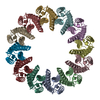+Search query
-Structure paper
| Title | Substrates bind to residues lining the ring of asymmetrically engaged bacterial proteasome activator Bpa. |
|---|---|
| Journal, issue, pages | Nat Commun, Vol. 16, Issue 1, Page 3042, Year 2025 |
| Publish date | Mar 28, 2025 |
 Authors Authors | Tatjana von Rosen / Rafal Zdanowicz / Yasser El Hadeg / Pavel Afanasyev / Daniel Boehringer / Alexander Leitner / Rudi Glockshuber / Eilika Weber-Ban /   |
| PubMed Abstract | Mycobacteria harbor a proteasome that was acquired by Actinobacteria through horizontal gene transfer and that supports the persistence of the human pathogen Mycobacterium tuberculosis within host ...Mycobacteria harbor a proteasome that was acquired by Actinobacteria through horizontal gene transfer and that supports the persistence of the human pathogen Mycobacterium tuberculosis within host macrophages. The core particle of the proteasome (20S CP) associates with ring-shaped activator complexes to degrade protein substrates. One of these is the bacterial proteasome activator Bpa that stimulates the ATP-independent proteasomal degradation of the heat shock repressor HspR. In this study, we determine the cryogenic electron microscopy 3D reconstruction of the complex between Bpa and its natural substrate HspR at 4.1 Å global resolution. The resulting maps allow us to identify regions of Bpa that interact with HspR. Using structure-guided site-directed mutagenesis and in vitro biochemical assays, we confirm the importance of the identified residues for Bpa-mediated substrate recruitment and subsequent proteasomal degradation. Additionally, we show that the dodecameric Bpa ring associates asymmetrically with the heptameric α-rings of the 20S CP, adopting a conformation resembling a hinged lid, while still engaging all seven docking sites on the proteasome. |
 External links External links |  Nat Commun / Nat Commun /  PubMed:40155375 / PubMed:40155375 /  PubMed Central PubMed Central |
| Methods | EM (single particle) |
| Resolution | 2.5 - 4.1 Å |
| Structure data |  EMDB-19150: Cryo-EM map of the 20S proteasome in complex with the bacterial proteasome activator Bpa from M. tuberculosis  EMDB-19151: 20S proteasome from M. tuberculosis  EMDB-19153: M. tuberculosis bacterial proteasome activator Bpa with bound substrate  EMDB-19159: truncated M. tuberculosis bacterial proteasome activator Bpa EMDB-19162, PDB-8rgx: |
| Source |
|
 Keywords Keywords | CHAPERONE / protein degradation / quality control / proteasomal activator / mycobacteria |
 Movie
Movie Controller
Controller Structure viewers
Structure viewers About Yorodumi Papers
About Yorodumi Papers





 mycobacterium tuberculosis h37rv (bacteria)
mycobacterium tuberculosis h37rv (bacteria)